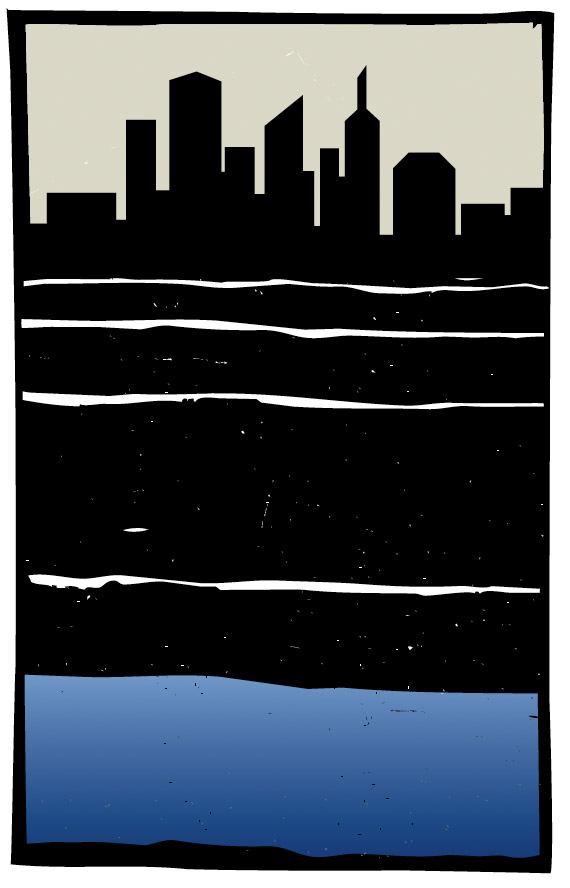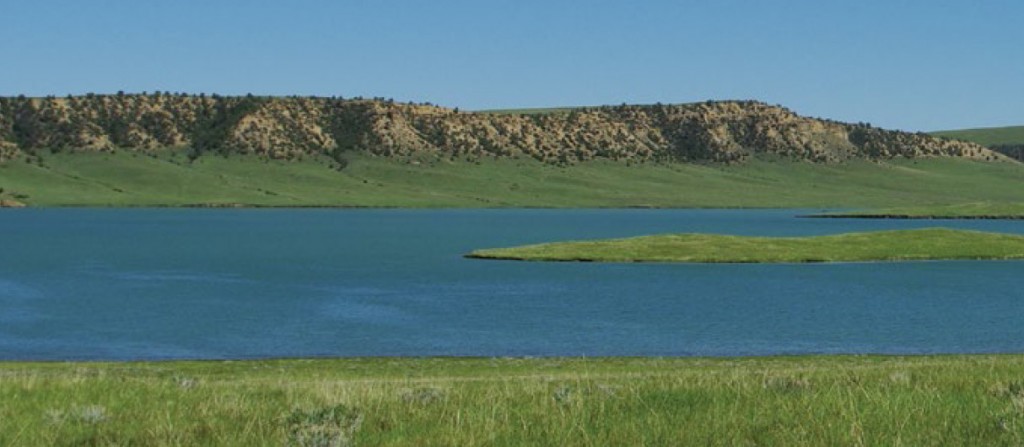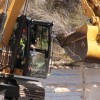Underground Storage Could Help Cities Sustain Water Supplies
In 2009 Lytle Water Solutions, LLC, a geology consulting firm, constructed a small, rectangular basin in a groundwater well field outside of Cheyenne, Wyoming. Over the following six months nearly 110 acre feet of water—that’s enough to fill about 54 Olympic swimming pools, or enough to supply about 193 Cheyenne homes for one year—quietly flowed into the straight-edged dirt pit and sank into the ground.
This was a test commissioned by the Cheyenne Board of Public Utilities in partnership with the Wyoming Water Development Commission to evaluate the potential for “aquifer storage and recovery,” known as ASR. Cheyenne sits over the edge of the Ogallala Aquifer, a massive groundwater reservoir that stretches from central Texas to southern South Dakota. The Ogallala supplies almost a third of the groundwater that goes to irrigation in the US, plus water for homes, cities, and other uses. But it, like many aquifers around the country and world, is in trouble. For the last half century, water withdrawal from the aquifer has exceeded the amount of “recharge,” or rainfall and seepage from streams and canals that flows back into the aquifer. Cheyenne has seen groundwater production from its wells decline as the aquifer water table has fallen. If current trends in agricultural expansion, population growth, and drought continue, farms over parts of the aquifer will start to lose access to groundwater all together, and water use from the aquifer will be unsustainable.
The Ogallala is not alone. Cities from Gillette to Juarez have had to drill deeper and deeper wells to draw water from declining water tables. Even as these water caches drain away, water managers race to secure water supplies for the future. Strategies include diversifying sources of water, recycling wastewater, incentivizing water conservation, and storing water on the surface and underground. Storage usually refers to building new reservoirs and expanding existing ones. But reservoirs have their shortcomings. They can only be placed in certain areas, namely constricted canyons or valleys with a supply of water.
“Permitting reservoirs is really tough in Colorado these days,” says Bill Hahn, a professional geologist who has worked on several aquifer recharge projects and a proposed Two Forks Reservoir. “They worked on permitting for 10 years and spent millions and it got killed. New reservoirs are few and far between.”
Once built reservoirs collect silt, slowly filling from the bottom up. And reservoirs’ large surface areas evaporate off huge amounts of water. Lake Mead, the largest reservoir in the United States, evaporates 6 to 8 feet of water per year, which adds up to hundreds of thousands of acre-feet over the nearly 70-mile-long surface of the reservoir. ASR can avoid some of these problems. It has potential to offer a more sustainable alternative to reservoirs for future water storage. Water managers are tackling projects to test, study, and implement this technology.
![]()
Several conditions need to line up for ASR to work. The process requires clean surplus water, an underground aquifer with space in it, and a nearby community in need of the water. Each project is different based on the source of the water, type and location of aquifer, and other factors.
The first requirement, excess water available for storage, could come from spring floodwaters, briny groundwater pumped up and cleaned, storm water runoff from cities, recycled municipal water, desalinated seawater, or other sources. In Cheyenne’s case, the city proposed using excess surface water available in its reservoirs during spring runoff. El Paso, Texas, recharges its aquifer with treated storm water and city wastewater. The Arizona Water Banking Authority diverts water through canals from the Colorado River to store in aquifers near Phoenix and Tucson.
 The water has to be clean enough to mix into a drinking water aquifer. Storm water runoff or saline groundwater requires extensive treatment. Most states require any injected water be cleaned enough that it won’t contaminate the aquifer, usually to potable drinking water standards. Then the clean water has to be piped to the aquifer.
The water has to be clean enough to mix into a drinking water aquifer. Storm water runoff or saline groundwater requires extensive treatment. Most states require any injected water be cleaned enough that it won’t contaminate the aquifer, usually to potable drinking water standards. Then the clean water has to be piped to the aquifer.
The two main methods for putting water into an aquifer are infiltration and injection. The Arizona Water Banking Authority uses spreading basins to infiltrate water into aquifers. These are big shallow ponds with permeable floors the water can soak through. The basins let a couple of feet of water per day filter into the aquifer. That water can be pumped out days, months, or even years later. These spreading basins do lose a small amount of water to evaporation, about 1 percent of the total volume placed in aquifer storage according to Bob Marley, technical specialist and hydrogeologist for Daniel B. Stephens and Associates, Inc., an Albuquerque-based company specializing in ASR. Spreading basins efficiently deliver water to the aquifer, eliminating the long-term evaporative losses associated with traditional surface reservoirs.
Infiltration works best for shallow aquifers. Infiltration basins are relatively low-tech, and thus less expensive and easier to maintain than some other methods. In addition, they can clean the water as it soaks down through the soil layers. Chemicals in the water affix to minerals in the ground as the water seeps toward the aquifer. In some places, untreated river or canal water can safely be infiltrated into aquifers.
The other method for aquifer recharge uses injection wells, similar to wells that pump water out of aquifers. A motorized pump forces water down the injection well into the aquifer. Sometimes gravity of water falling down the pipe creates enough pressure for injection. Wells used to pump water out of aquifers can be retrofitted to work as injection wells. In fact, some injection systems use the exact same wells to put excess water into the aquifer in the spring as they do to withdraw the water later in the summer. Injection wells disturb only a small surface area. They can be placed anywhere, even in the middle of a city. They can also put water into aquifers too deep for infiltration basins.
A third option is vadose zone wells, sometimes called dry wells. The “vadose zone” is the area between the top of the aquifer and the ground surface. Hydrologists might dig a vertical tunnel partway to the aquifer, insert a perforated pipe, and fill around the pipe with something permeable, like sand. Water will flow down the well and then soak the rest of the way to the aquifer. Vadose zone wells can collect surges of surface water, such as during a storm or flood, and ensure that water unable to soak down from the surface on its own reaches an aquifer. They also clean the water on the way, though not as thoroughly as infiltration basins.
“An above ground tank could store 5 million gallons. Aquifer recharge systems can put that much in the ground every day,” says Marley. “If you have the right geology an aquifer can store water on the scale of a small reservoir. Not Lake Mead, but a midsize reservoir range—500 to 10,000 acre feet per year of water storage, up to 50,000 to 100,000 acre feet per year in other places.”
![]()
In order for ASR to be viable for a community, the city needs a nearby aquifer with available space for added water, as well as a reliable surplus of clean water to infiltrate or inject into the aquifer. There must be sufficient water demand now or in the forecast to justify the cost of the studies and tests leading up to the ASR project and to develop the infrastructure and oversee the implementation, a process that can take years. Finally, the city needs to be sure it can control and effectively recover the water it puts into the aquifer.
Cheyenne, Wyoming, is not the quintessence of an ASR-ready town, but the community does have the necessary surplus water, depleted aquifer, and thirsty population. The city’s “Managed Aquifer Recharge, Storage, and Recovery Project” studied ASR’s potential.
Geologists at Lytle Water Solutions (LWS), the Colorado-based company that conducted the study, found feasible test sites at two groundwater well fields west of the city. They first tested an infiltration basin approach. The water soaked into the ground like it was supposed to, but a 15-foot-thick layer of clay about 45 feet underground blocked the water from reaching the aquifer. Nearby monitoring wells did not detect any water increases in the aquifer. LWS suggested a vadose zone well penetrating the clay layer could solve the problem while letting the water infiltrate the remaining 75 or so feet to the aquifer. But the Wyoming Department of Environmental Quality denied the necessary permits because the agency feared a vadose zone well would let contaminants into the aquifer.
Following the infiltration basin study, LWS also tested an injection well. They retrofitted an existing municipal well so it could pump water both into and out of the aquifer. Over nearly three months LWS intermittently injected 93 acre-feet of water into the aquifer and pumped water back out to clean the well and test recovery. LWS determined that injecting water into Cheyenne’s aquifer could be effective. However, the Cheyenne Board of Public Utilities was concerned about tracking the water’s movement. They were not confident they would be able to recover their injected water. Following recent wet years, the city has not pursued the project any further.
![]()
Wyoming’s governor appoints individuals to the Wyoming Water Development Commission to develop water projects funded by severance tax money. The group has explored several potential applications for ASR over the years. Usually the commission hires one consulting firm or another to conduct analyses and tests. Reports on these projects are posted to the Wyoming Water Resources Data System website.
Many ASR studies in Wyoming focused on the southeast corner of the state near Cheyenne. In the late 1980s, the commission investigated the potential for capturing spring floodwater to recharge a groundwater aquifer being depleted by irrigation. Floods were damaging roads and other infrastructure along the lower reaches of Crow Creek, downstream from Cheyenne. The report suggested installing spreader dikes in the stream to slow the floodwaters and let them soak into the aquifer, but more study was needed and the project was never carried out. In the early 2000s Laramie County also looked into recharging aquifers in the Lodgepole Creek Basin to help irrigators, but found it would be too expensive.
In the 2000s, the state began to look into ASR in the Green River Basin in western Wyoming. The geologists on the study determined the groundwater quality was too marginal for drinking or irrigation and the local aquifers lacked available space for injection. However, an idea arose to divert spring floodwaters into ponds near the river for infiltration. Then irrigators could either pump the water out of wells, or take it from the river as it soaked back to the main channel later in the summer. “Water banking via off-channel recharge could prove to be a valuable and effective method of reducing or eliminating late season water shortages for several reaches in the Upper Green River Basin during dry years,” the report concluded in 2001.
In the northeast corner of the state, the city of Gillette has also looked into groundwater storage. Gillette gets most of its drinking water from groundwater aquifers under the city and at the edge of the Black Hills near Devil’s Tower 42 miles to the northeast. The city has had to deepen its in-town wells, from 400 feet in the 1970s to 700 feet in the 1980s. Then, in the late 90s, a coalbed methane boom started producing massive amounts of water of various qualities. In 2001 the city asked the Wyoming Water Development Commission to help it look into injecting produced coalbed methane water into the city’s aquifer. This study found that the water was of too poor quality to use for drinking water. Furthermore, the city of Gillette had trouble coordinating with the coalbed methane producers to transfer the water. Finally, the only parts of the aquifer viable for ASR were too small to warrant the infrastructure required to bring the water to the city.
![]()
Wyoming has yet to find a suitable application for ASR, but some densely populated, thirsty Colorado cities are already recharging aquifers as a way to clean and store water for the future.
One of the most advanced ASR projects in Colorado is the Prairie Waters Project. The city of Aurora, a Denver suburb, created Prairie Waters to reclaim the city’s effluent water. Prior to 2010, Aurora brought half of its water in from distant water basins to the south and west. The other half originated in the South Platte River Basin. Aurora was discharging treated water from its wastewater treatment plant into the South Platte River. Because half of that effluent was from water Aurora brought into the South Platte River Basin from elsewhere, the city still had a right to use it.
The Prairie Waters Project, which began delivering water in 2010, diverts water from the South Platte River downstream of the Aurora wastewater treatment plant and sends it through underground aquifers to both clean and temporarily store the water. The filtration provided by the sand and aquifer substrates underground removes pharmaceuticals and other contaminants. The city then uses wells to pump the cleaned water back out of the ground and pipes it 34 miles back to the city. The system added 10,000 acre feet of water to the Aurora City water system, about 20 percent of the city’s supply, and will expand up to 50,000 acre feet by 2030.
The city of Denver and its utility, Denver Water, has historically relied almost entirely on surface water and now is investigating the potential to store water in a deep aquifer under the city limits. This would likely entail recharging excess surface water during spring runoff season and withdrawing that water later in the year during times of greater need. The Centennial Water and Sanitation District, which serves Highlands Ranch, Colorado, injects excess surface water that has been treated to drinking water quality through 19 wells into its aquifer to slow aquifer depletion. And Castle Rock south of Denver has historically relied exclusively on groundwater from several Denver Basin Aquifers, which do not naturally recharge from snowmelt or rain water. As the aquifer declines, the city is now lifting water from as deep as 1,400 feet, which requires heavy-duty pumps. In addition to diversifying its water supply with renewable surface water sources, the city is investigating potential to recharge its aquifer. In 2014 the city retrofitted some existing wells to test ASR.
Alongside their infrastructure projects, these Colorado communities have also emphasized water conservation. Most conservation measures focus on altering landscaping. Lawn care and other outdoor water uses account for more than half of all domestic water use. Conservation measures in Aurora reduced per capita daily water consumption from 175 gallons to around 135, a nearly 25 percent decrease, which saves millions of gallons per year the city would otherwise have to secure, treat, and transport.
Storing water in an aquifer, “extends the life of the resource,” says Marley, the hydrogeologist in Albuquerque. “As a city, as soon as you discharge the water, there are no further benefits. If you can collect it, treat it, recycle it a few times, you get more bang for your buck.”
Colorado’s large and thirsty human population, diminishing aquifers, and lack of space for new reservoirs all converge to make ASR a viable option there. Unlike Colorado, Wyoming does have space for new reservoirs, but they also face hurdles related to environmental permitting, evaporative losses, and siltation. Meanwhile, Cheyenne’s Aquifer Recharge, Storage, and Recovery Project is currently on hold.
“I think the technology has matured enough now that we have plenty of examples,” says Marley of ASR. “It’s now more common as a potential solution. But a project can stall out. The governing bodies and teams working on it have to be committed. They have to stay with it. It doesn’t take as long as to build a reservoir, but it will be a multiyear event.”
Kevin Boyce, project manager at the Wyoming Water Development Commission, has worked on several ASR tests and studies across Wyoming over the years. While he agrees that Wyoming needs to find sound methods for storing water into the future, our situation as a low-population headwaters state means we are not desperate enough for water storage at this time to invest the resources ASR requires. “We have some proactive studies, but nothing is off the ground,” says Boyce.
Water storage will remain a primary concern for Wyoming water managers over the coming decades. Now that the state has tentatively explored aquifer recharge and found some promising ideas, when the time is right ASR will likely resurface.
By Emilene Ostlind
Note: While this story was in production, the Laramie County Commissioners hired the Ruckelshaus Institute, publisher of this magazine, to facilitate meetings of a newly formed steering committee tasked with solving the aquifer depletion problem for irrigators downstream of Cheyenne, Wyoming.
Resources
Bouwer, Herman, David Pyne, Jess Brown, Daniel St. Germain, Tom Morris, Christopher Brown, Peter Dillon, and Mitchell Rycus. Design, Operation, and Maintenance for Sustainable Underground Storage Facilities. Denver, CO: Awwa Research Foundation, 2008.
City of Cheyenne Board of Public Utilities. 2013 Cheyenne Water and Wastewater Master Plans: Volume 3 – Source Water Supply and Delivery. Prepared by HDR Engineering, AMEC Earth and Environmental, and AVI Professional Corporation, November 27, 2013.
Lytle Water Solutions, LLC. Final Report: Managed Aquifer Recharge, Storage, and Recovery Project. Prepared for the Cheyenne Board of Public Utilities, January 2011.



